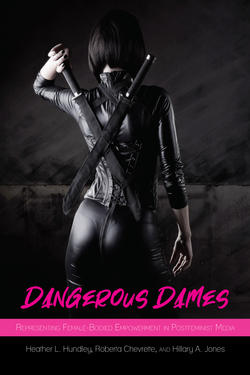Читать книгу Dangerous Dames - Heather Hundley - Страница 15
На сайте Литреса книга снята с продажи.
Our Approaches
ОглавлениеOur approaches are grounded in our training as critical/cultural communication scholars specializing in rhetorical criticism and media studies. We view ←7 | 8→texts as created artifacts manifesting symbols that have consequences for audiences’ beliefs, values, imaginations, and actions. Although this may seem obvious, these aspects of media—their symbolic nature and their consequentiality—are unique contributions rhetorical scholars bring to studying media.
We acknowledge a range of reading positions regarding media’s rhetorical functions. They include the uncritical view of media as directly representing reality, expressed positions that mediated texts are “mere entertainment,” and views of media as potentially perpetuating beliefs for some audiences but not for the individual expressing the view. As rhetoricians and teachers, we challenge these claims. We view media as profoundly impactful in their circulation of specific representations. Even though they emerge within particular histories, contexts, and media landscapes, they are malleable. We believe rhetors make symbolic choices—whether deliberately, routinely, or inadvertently—when creating a text in any medium. It is the rhetorical critic’s task to investigate these resulting symbols, and it is our task as teachers to help students understand how media and representations function rhetorically.
Rhetorical criticism entails close, methodical analysis of a symbolic artifact. In analyzing representations in film, television shows, and other media, rhetorical scholars might analyze many aspects of a text. For example, in studying characters, the critic might consider what characters say, the narrative functions they play (e.g., protagonist, villain, supporting character), their occupations, their physical bodies (tall, short, fat, thin, attractive, etc.), their capabilities (strong, weak, superhuman, skilled, able-bodied, apprenticing, etc.), their interactions with others, the clothes they wear, the places they appear… and so on. In addition, rhetorical scholars of media attend to details of production, such as cinematography, sound design, sets, lighting, and other elements, depending on the particular medium. Finally, they may consider political economy and reception, attending to ownership, production, circulation, dissemination, and audience.
As McGee (1990/2009) famously articulated, rhetorical scholars do not encounter and critique bounded objects of study; instead, they create their objects through the choices they make with their critical analyses. In this book, we have chosen to construct artifacts including films, television shows, and video games. We read these texts as constituting and circulating ideas about gender, feminine/ist empowerment, and postfeminism that influence the audiences who encounter them.
Theory and method closely intertwine in rhetorical criticism, with different theories providing lenses through which we analyze texts (Jasinski, 2001). ←8 | 9→The theories that most centrally inform our project and the stances we take in this book are drawn from critical/cultural studies and feminist approaches. An awareness of theoretical intersections and lived experience undergirds the work of both critical/cultural and feminist scholars. Cultural studies scholars routinely study subjects and the positions available to them in society and in cultural narratives (Hall, 1997). For those of us who opt to study media texts, representations provide a fruitful way to access the cultural imaginary (Rushing & Frentz, 1991). Barthes (1974) delineates how texts can range from readerly (very open to interpretation) to writerly (more constrained by the rhetor’s purported intended meaning). The representations in both types of texts help us account for the rhetorical constraints and possibilities present in society.
Critical/cultural approaches further attune critics to the significance of popular culture in perpetuating ideology and hence foreground questions of power as it relates to sociopolitical structures, institutions, and everyday practices. As critical/cultural scholars seeking to advance social justice, we study symbolic representations to illuminate how narratives articulate and how they function rhetorically. Representations produce and govern knowledge, expectations, what we envision as ideal, and even the nature of reality. When we analyze representations, whether identities or other factors that shape culture (e.g., colonialism, displacement, political economy, family structures, etc.), scholars can explore how these mediated visions affect how we see ourselves as individuals and societies. Therefore, our various chapters employ a range of critical theories to inform our readings of specific texts; these include ideological criticism, biopower, necropolitics, critical race theory and whiteness studies, gender performativity, and posthumanism.
Feminist approaches focus our attention on the gendering of representations, identities, and subjectivities. Our analyses take an intersectional approach that understands systems of gender as constructed through and in relation to other interlocking systems of power and oppression including race, nation, class, ability, sexuality, and empire (Carastathis, 2016; Crenshaw, 1989, 1990; Davis, 1983; Hill Collins, 2000; Hill Collins & Bilge, 2016; Moraga & Anzaldúa, 2015). Feminist approaches understand media as located within wider visual economies that produce gendered gazes and the imagistic manipulation of bodies (Dow, 2006; Lotz, 2001; Modleski, 1991; Projansky, 2001). Finally, feminist approaches attend to the ways women’s agency frequently manifests through the construction of alternative sources of power within systems of subordination.
←9 | 10→
The rigorous analyses of media’s ideological functions we engage in throughout this book might seem to discount the notion that media offer audiences sources of pleasure, relaxation, and escape. We suspect this is why students often initially express reluctance to treat entertainment media as sites where oppressive and exploitative power relations are perpetuated. As bell hooks notes, audiences wish to reserve “a certain sense of magic” for the arena of media (Jhally, 1997). We do not deny media’s ability to create, inspire, entertain, and provide audiences with pleasure. In nearly all the cases featured here, we enjoyed viewing (or playing) the artifacts we analyzed. Barthes (1975) differentiates between plaisir, pure pleasure more akin to escapism, and jouissance, a joy grounded in play more akin to epiphany. Ott (2004, 2007) extends this, detailing the erotics of reading, emphasizing the joy of engaging with media texts. We experienced plaisir, and we derived an eroticized jouissance from analyzing them critically and deeply in order to render a complex, nuanced reading of each one.
